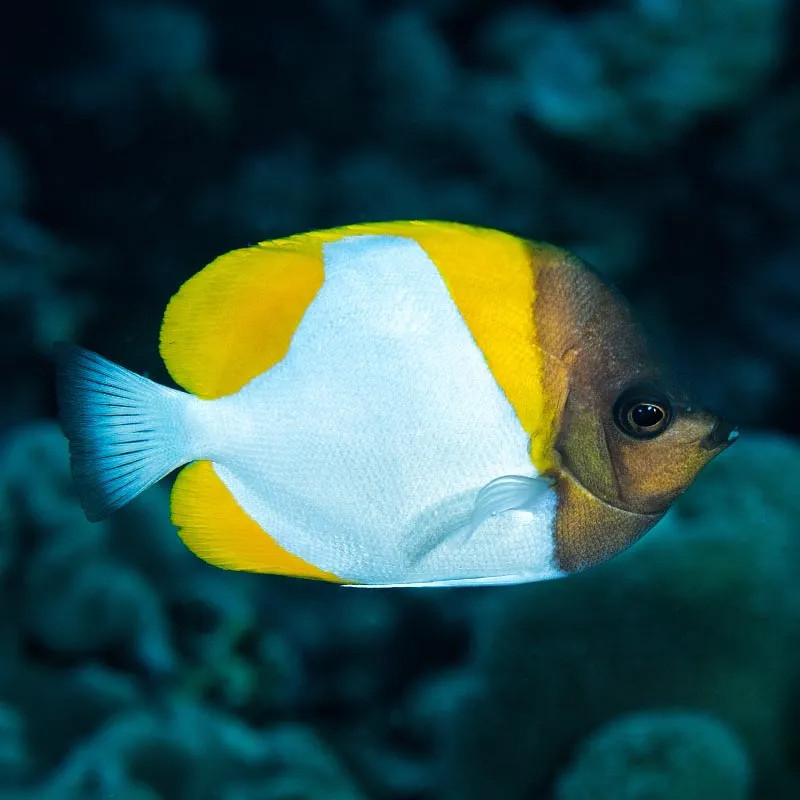Stocks Available
COPPERBAND BUTTERFLYFISH M
SKU:225787
CHELMON ROSTRATUS
3-4.25 INCH

Stock Available
Introduction: • Species: Black Zoster • Common Names: Black Zoster, Blacktail Triggerfish • Natural Habitat: Found in the tropical and subtropical waters of the Indo-Pacific region, typically residing in coral reefs and rocky substrates. Physical Characteristics: • Appearance: This fish features a robust, oval-shaped body with a striking black coloration and distinctive white or yellow markings on the fins. It has a prominent, blunt snout and a strong jaw equipped with sharp teeth. • Size: Grows to a length of about 8-12 inches (20-30 cm). • Lifespan: Can live for over 10 years in a well-maintained aquarium environment. Habitat Requirements: • Tank Size: Requires a minimum tank size of 100 gallons to provide ample swimming space and suitable territories. • Water Conditions: o Temperature: Prefers a range of 74-82°F (23-28°C). o pH: Thrives in slightly alkaline conditions, with a pH of 8.1-8.4. • Aquascaping: The tank should include plenty of live rock, caves, and hiding spots to mimic its natural environment and reduce stress. Diet: • Primary Diet: Carnivorous; in the wild, it feeds on crustaceans, mollusks, and small fish. • Supplemental Feeding: In captivity, offer a varied diet of high-quality pellets, frozen foods like shrimp and fish, and occasional vegetable matter to maintain health. • Feeding Frequency: Feed small amounts 1-2 times daily to ensure proper nutrition and prevent overfeeding. Compatibility: • Temperament: Generally semi-aggressive; can be territorial, especially with similar-looking species or when kept in smaller tanks. • Suitable Tank Mates: Best kept with larger, robust fish that can handle its assertive nature, such as other triggerfish, tangs, and large wrasses. • Incompatibilities: Avoid housing with small fish or overly timid species that may become targets for aggression. Care Level: • Difficulty: Moderate; requires stable water parameters and a varied diet for optimal health. • Health Monitoring: Regularly check for signs of stress, disease, or parasites; watch for any injuries that may occur due to aggression. Breeding: • Breeding in Captivity: Rarely bred in home aquariums; not much information is available about their breeding behaviors. • Spawning: Typically forms pairs in the wild, with egg-laying behavior observed in suitable conditions. Economic Considerations: • Market Demand: Gaining popularity among marine aquarium enthusiasts for its unique appearance and behavior. • Wholesale Pricing: Prices can vary depending on size and availability; larger specimens tend to command higher prices. • Retail Pricing: Generally sold at moderate to high prices in aquarium stores. Sustainability and Conservation: • Wild Population: Populations are considered stable, but threats include habitat degradation and overfishing. • Aquaculture Efforts: Limited success in breeding this species in captivity; most available in the trade are wild-caught. • Regulations: Adherence to local and international conservation regulations is essential to ensure sustainable trade practices. Conclusion: The Black Zoster is an attractive and resilient addition to marine aquariums, appreciated for its bold coloration and dynamic presence. With proper care and suitable tank conditions, this species can thrive, enhancing the beauty and diversity of reef environments while providing an engaging experience for aquarium enthusiasts.
Data sheet
16 other products in the same category:
Customers who bought this product also bought: